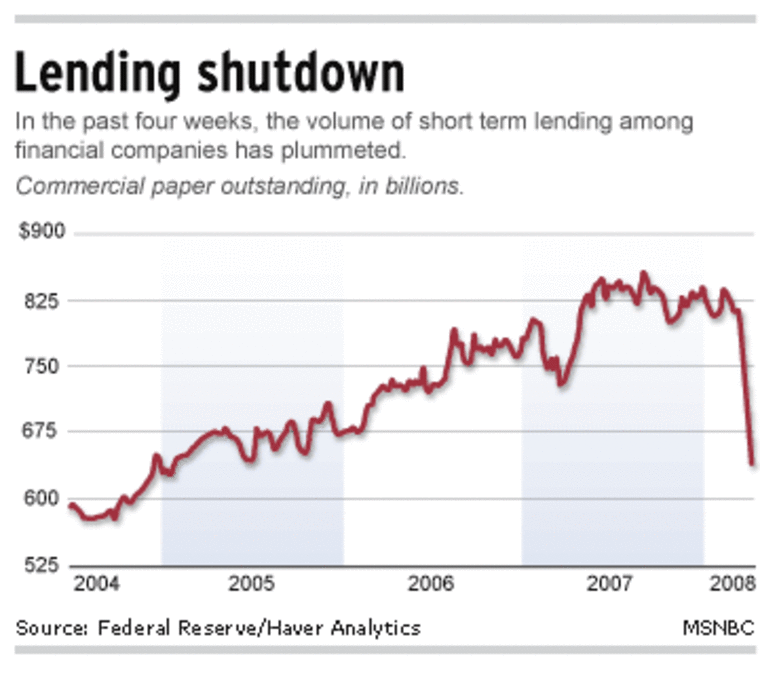Faced with the continued unwinding of the global financial system, the Treasury is opening a new front in its battle to right the banking system. By buying stakes directly, the government would immediately bolster banks’ capital foundations. But such a move — as the details of how it will be done are still sketchy — carries its own set of risks.
Treasury Secretary Henry Paulson said Wednesday that the financial bailout bill approved by Congress gives him wide authority to inject capital into the banking system. The White House confirmed Thursday that could include having the government take a direct ownership stake in banks.
The move follows action by the British government Wednesday to spend hundreds of billions of pounds to rescue its banking system.
In just the past few weeks, the contraction of lending has accelerated. Banks are unwilling to lend to each other out of fears that the borrower may be the next institution to fail. As the global lending machinery slows, the economy slows with it. The longer it takes to get money flowing again, the greater the risk of a deep and prolonged recession.
The plan would have little immediate impact on the safety of individual deposits. The Federal Deposit Insurance Corp. recently raised insurance limits individual accounts. But that may not be enough to calm nervous depositors — who may decided to move money to countries with unlimited guarantees on bank deposits.
“Internationally several countries — Germany, Ireland, and so forth — have guaranteed all deposits,” said William Seidman, “We'll have to see if that drains money out of the United States.”

The Treasury’s investment of billions of dollars indirect ownership of banks would constitute a stunning reversal of the government’s policy of minimal intervention in free markets. Much of the opposition to the $700 billion financial bailout came from Republicans who opposed using tax dollars to backstop failing financial institutions
Supporters of the idea, including Sen. Charles Schumer (D-NY), who chairs the Joint Economic Committee, said having the Treasury buy stakes in banks could insure that taxpayers benefit later.
"When the market recovers, the federal government would profit," Schumer said.
The idea is not without risks. If banks turn over stock to the government, it dilutes the value of shares already held by investors. Lowering value of already-battered bank stocks could put greater pressure on lending.
“If they're going to go in with an injection of capital into banks where the taxpayer is going to profit from that, that drives down equity capital in banks,” said David Malpass, a senior Treasury official in the Reagan administration. “It's a giant sucking sound away from bank equity and away from bank equity capital and from lending. Banks won't lend.”
Banks don’t have to sell stock to the government. But under the terms of the recently enacted Troubled Asset Relief Program, any bank that wants to sell bad mortgage-backed debt to the government have to give the government, in return, the right to buy some of its stock. Banks that have loaded up their books with these bad mortgage assets may have no choice.
“The only reason they're putting money in those banks and the banks are accepting is that the banks will go broke without it,” said Bill Seidman, former chairman of the Federal Deposit Insurance Corp. “They're not taking this because they love the government. They're taking it because the regulator is saying, ‘You don't have enough capital. If you don't get more capital, we're going to close you down.’”
Some critics suggest that government regulations may be a big part of the problem banks are now facing. The huge losses they’ve booked are due in large part to the heavy writedowns in the value of investments back by mortgages — for which there are no buyers. Most people are still paying their mortgages, so these investments are almost certainly worth something.
But because of the uncertainty about rising defaults and falling home prices, banks are required to “mark” the value of these investments to the “market price,” which may be far less than they’re really worth. Congress recently gave the Securities and Exchange Commission more leeway to relax those accounting standards.
“The SEC has destroyed $500 billion of bank capital by its senseless marking to market of these assets for which there is no market,” said William Isaac, former FDIC chairman. “And that has destroyed $5 trillion of bank lending. That's a major issue in the credit crunch we're in right now. The banks just don't have the capital to start lending right now because of these horrendous markdowns that the SEC's approach required.”
But allowing banks to assign a higher value to these investments could backfire — by undermining confidence in bank bookkeeping. That’s the main purpose behind the TARP program. The hope is that once the government begins buying these mortgage-backed investments, bankers, investors and depositors will get a better idea of how much capital banks have to work with — and which banks are at risk of going under.
That uncertainty about how much mortgage related assets are worth could also undermine the government efforts to pump money into the system by buying up stakes in banks.
“The problem is if you capitalize the banks that hold these troubled assets — but there’s no clarity or transparency or price discovery process for these assets — then that capital could quickly evaporate,” said David Resler, chief economist at Nomura Securities. “You need to have both.”